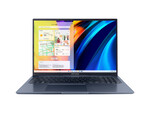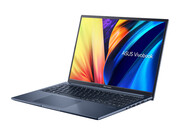Asus Vivobook 16X M1603, R7 5800H
Specifiche tecniche

Price comparison
recensioni per Asus Vivobook 16X M1603, R7 5800H
Sorgente: Laptop Media
 EN→IT
EN→ITWhen you want a laptop that has the performance of a big gaming machine, you need to make sacrifices. Especially if you want it to be affordable. Well, this is exactly the case with the Vivobook 16X (M1603). Its IPS panel has a WUXGA resolution, 16:10 aspect ratio, comfortable viewing angles, and a good contrast ratio. Its backlight doesn’t use PWM for brightness adjustment, but on the other hand, the color coverage is only 50% of the sRGB color gamut. Although the laptop is made out of plastic, it has one strong feature when it comes to the body – its coating. ASUS has covered all body panels with an antimicrobial layer, which attracts all microbes and then kills them off. Quite sadistic, but also beneficial. In addition to that, the port selection is robbed of an SD card reader, while the USB Type-C port can only be used for data transfers. Also, some of the memory (8GB to be precise) has been soldered to the motherboard. Further expansions are possible via the single SODIMM slot. In terms of battery, you get between 8 and 10 hours on a single charge, depending on your activities – watching videos, or browsing the Web. Using more demanding software, however, will drain it significantly more quickly, due to the power-hungry processor. Speaking of which, it is really powerful. Even though it is a couple of generations old, one can still reap the benefits of AMD’s bold design back in the day. So, if you are looking for a machine that is capable of delivering all you need, at a low price, and still allows you to play light games – get the Vivobook 16X (M1603). Don’t miss to check out the OLED version of this device.
Singola recensione, disponibile online, Lunghissimo, Data: 02/23/2023
Sorgente: Laptop Media

Supporto, disponibile online, Cortissimo, Data: 02/23/2023
Commenti
AMD Vega 8:
Scheda grafica integrata delle APU Ryzen basate sull'architettura Vega con 8 CU (= 512 shaders) e un clock fino a 1.750 MHz.
Ridurre la distanza delle Schede Grafiche per gli utenti che vogliono utilizzare il videogiochi. I nuovi giochi dovrebbero funzionare su queste schede, ma con riduzione dei dettagli e risoluzione mediocre.
>> Ulteriori informazioni le potete trovare nel nostroConfronto delle schede grafiche e nella nostra Lista dei Benchmark.
R7 5800H:
APU Octa-Core mobile che utilizza core Zen 3 con clock da 3,2 a 4,4 GHz e una scheda grafica Vega con 8 CU con clock fino a 2000 MHz.
>>Ulteriori informazioni le potete trovare nel nostroConfronto dei processori per portatili.




